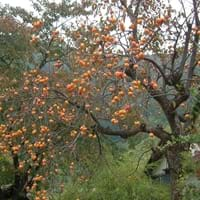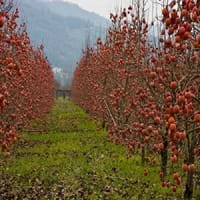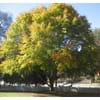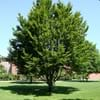Life Span
Perennial
Perennial
Origin
China, Korea
China
Types
Fuyu Persimmons
Hachiya Persimmons
Among(Ye mon)
Maru Persimmons
Not available
Habitat
Woodlands
secondary forest, Sunny Edge, Woodland Garden Canopy
USDA Hardiness Zone
6-10
6-10
Sunset Zone
H1, 6, 7, 8, 9, 12, 14, 15, 16, 18, 19, 20, 21, 22, 23, 24
H1, 6, 7, 8, 9, 12, 14, 15, 16, 18, 19, 20, 21, 22, 23, 24
Habit
Pyramidal
Pyramidal
Flower Color
Light Yellow
Light Yellow
Flower Color Modifier
Bicolor
Bicolor
Fruit Color
Orange
Orange
Leaf Color in Spring
Green
Green
Leaf Color in Summer
Green
Green
Leaf Color in Fall
Yellow, Burgundy, Orange Red
Yellow, Burgundy, Orange Red
Leaf Color in Winter
Not Available
Not Available
Leaf Shape
Elliptic
Pinnate
Plant Season
Summer, Fall, Winter
Summer, Fall, Winter
Sunlight
Full Sun, Partial Sun
Full Sun, Partial Sun
Growth Rate
Medium
Medium
Type of Soil
Clay, Loam
Clay, Loam
The pH of Soil
Acidic, Neutral
Acidic, Neutral
Soil Drainage
Well drained
Well drained
Tolerances
Not Available
Not Available
Where to Plant?
Ground
Ground
How to Plant?
Seedlings
Grafting, root cutting, Seedlings
Plant Maintenance
Medium
Medium
Watering Requirements
Do not water excessively, Do not water frequently, Prefer drip-irrigation instead of Over-head watering
Requires regular watering
In Summer
Lots of watering
Lots of watering
In Spring
Moderate
Moderate
In Winter
Average Water
Average Water
Soil pH
Acidic, Neutral
Acidic, Neutral
Soil Type
Clay, Loam
Clay, Loam
Soil Drainage Capacity
Well drained
Well drained
Sun Exposure
Full Sun, Partial Sun
Full Sun, Partial Sun
Pruning
Remove damaged leaves, Remove dead branches, Remove dead leaves
Remove damaged leaves, Remove dead branches, Remove dead leaves
Fertilizers
All-Purpose Liquid Fertilizer, Apply N-P-K
All-Purpose Liquid Fertilizer
Pests and Diseases
Caterpillars, Mealybugs, Nematodes, Red blotch
Caterpillars
Plant Tolerance
Drought, Full Sun, Variety of soil types
Drought
Flowers
Insignificant
Insignificant
Flower Petal Number
Single
Single
Foliage Texture
Medium
Medium
Foliage Sheen
Glossy
Glossy
Self-Sowing
Not Available
Not Available
Allergy
Not Available
Abdominal pain, Anaphylaxis, Inflammation
Aesthetic Uses
Bonsai
Not Used For Aesthetic Purpose
Beauty Benefits
Not Available
Not Available
Environmental Uses
Air purification
Air purification
Medicinal Uses
Anthelmintic, Antitussive, Antivinous, Appetizer, Astringent, Demulcent, Expectorant, Laxative
Astringent, Cancer, Diarrhea
Part of Plant Used
Fruits
Bark, Fruits, Wood
Other Uses
Cosmetics
Used as a cereal in making bread, porridge, Used As Food, Used for flavoring in Liquors, dairy products, gelatins,puddings, meats, candies, etc.
Used As Indoor Plant
No
No
Used As Outdoor Plant
Yes
Yes
Garden Design
Edible, Fruit / Fruit Tree, Topiary / Bonsai / Espalier
Feature Plant, Fruit / Fruit Tree, Topiary / Bonsai / Espalier
Botanical Name
DIOSPYROS kaki 'Hongsi'
Diospyros virginiana
Common Name
Asian Persimmon, Hongsi Persimmon, Japanese Persimmon, Kaki
American persimmon common persimmon, sugar-plum,eastern persimmon
In Hindi
Japanese Persimmon
अमेरिकी ख़ुरमा
In German
Japanese Persimmon
amerikanische persimmon
In French
Persimmon japonais
Diospyros virginiana
In Spanish
El caqui japonés
Diospyros virginiana
In Greek
Ιαπωνικά Λωτός
American λωτός
In Portuguese
Persimmon japonês
Caqui americano
In Polish
japoński Persimmon
Amerykański persimmon
In Latin
Persimmon Italica
Diospyros virginiana
Phylum
Tracheophyta
Tracheophyta
Class
Magnoliopsida
Magnoliopsida
Family
Ebenaceae
Ebenaceae
Genus
Diospyros
Diospyros
Clade
Angiosperms, Asterids, Eudicots
Angiosperms, Asterids, Eudicots
Tribe
Not Available
Not Available
Subfamily
Not Available
Not Available
Number of Species
Not Available
Season and Care of Japanese Persimmon and American persimmon
Season and care of Japanese Persimmon and American persimmon is important to know. While considering everything about Japanese Persimmon and American persimmon Care, growing season is an essential factor. Japanese Persimmon season is Summer, Fall and Winter and American persimmon season is Summer, Fall and Winter. The type of soil for Japanese Persimmon is Clay, Loam and for American persimmon is Clay, Loam while the PH of soil for Japanese Persimmon is Acidic, Neutral and for American persimmon is Acidic, Neutral.
Japanese Persimmon and American persimmon Physical Information
Japanese Persimmon and American persimmon physical information is very important for comparison. Japanese Persimmon height is 760.00 cm and width 550.00 cm whereas American persimmon height is 760.00 cm and width 610.00 cm. The color specification of Japanese Persimmon and American persimmon are as follows:
Japanese Persimmon flower color: Light Yellow
Japanese Persimmon leaf color: Green
American persimmon flower color: Light Yellow
- American persimmon leaf color: Green
Care of Japanese Persimmon and American persimmon
Care of Japanese Persimmon and American persimmon include pruning, fertilizers, watering etc. Japanese Persimmon pruning is done Remove damaged leaves, Remove dead branches and Remove dead leaves and American persimmon pruning is done Remove damaged leaves, Remove dead branches and Remove dead leaves. In summer Japanese Persimmon needs Lots of watering and in winter, it needs Average Water. Whereas, in summer American persimmon needs Lots of watering and in winter, it needs Average Water.





